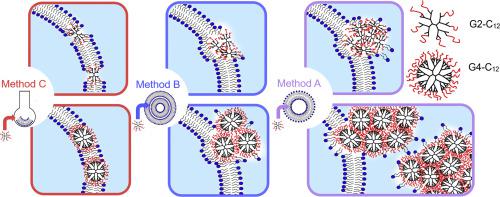当前位置:
X-MOL 学术
›
BBA Gen. Subj.
›
论文详情
Our official English website, www.x-mol.net, welcomes your
feedback! (Note: you will need to create a separate account there.)
Interactions between PAMAM dendrimers and DOPC lipid multilayers: Membrane thinning and structural disorder.
Biochimica et Biophysica Acta (BBA) - General Subjects ( IF 2.8 ) Pub Date : 2020-01-24 , DOI: 10.1016/j.bbagen.2020.129542 Laura J Fox 1 , Anna Slastanova 2 , Nicolas Taylor 2 , Magdalena Wlodek 3 , Oier Bikondoa 4 , Robert M Richardson 5 , Wuge H Briscoe 2
Biochimica et Biophysica Acta (BBA) - General Subjects ( IF 2.8 ) Pub Date : 2020-01-24 , DOI: 10.1016/j.bbagen.2020.129542 Laura J Fox 1 , Anna Slastanova 2 , Nicolas Taylor 2 , Magdalena Wlodek 3 , Oier Bikondoa 4 , Robert M Richardson 5 , Wuge H Briscoe 2
Affiliation

|
BACKGROUND
Understanding the structure of hybrid nanoparticle-lipid multilayers is of fundamental importance to their bioanalytical applications and nanotoxicity, where nanoparticle-membrane interactions play an important role. Poly(amidoamine) (PAMAM) dendrimers are branched polymeric nanoparticles with potential biomedical applications due to precise tunability of their physicochemical properties. Here, the effect of PAMAM dendrimers (2.9-4.5 nm) with either a hydrophilic amine (NH2) or a hydrophobic C12 chain surface termination on the 1,2-dioleoyl-sn-glycero-3-phosphocholine (DOPC) multilayers has been studied for the first time.
METHODS
DOPC multilayers were created by the liposome-rupture method via drop-casting dendrimer-liposome dispersions with the dendrimers added at different concentrations and at three different stages. The multilayer structure was evaluated via the analysis of the synchrotron X-ray reflectivity (XRR) curves, obtaining the bilayer d-spacing, the coherence length from the Scherrer (Ls) analysis of the Bragg peaks, and the paracrystalline disorder parameter (g).
RESULTS
Dendrimer addition led to lipid bilayer thinning and more disordered multilayer structures. Larger hydrophobic dendrimers caused greater structural disruption to the multilayers compared to the smaller dendrimers. The smallest, positively charged dendrimers at their highest concentration caused the most pronounced bilayer thinning. The dendrimer-liposome mixing method also affected the multilayer structure due to different dendrimer aggregation involved.
CONCLUSIONS
These results show the complexity of the effect of dendrimer physicochemical properties and the addition method of dendrimers on the structure of mixed dendrimer-DOPC multilayers.
GENERAL SIGNIFICANCE
These insights are useful for fundamental understanding of nanotoxicity and future biomedical application of nanocomposite multilayer materials in which nanoparticles are added for enhanced properties and functionality.
中文翻译:

PAMAM树状聚合物与DOPC脂质多层膜之间的相互作用:膜变薄和结构紊乱。
背景技术了解杂化纳米颗粒-脂质多层体的结构对于它们的生物分析应用和纳米毒性具有至关重要的意义,其中纳米颗粒与膜的相互作用起着重要的作用。聚(酰胺基胺)(PAMAM)树状聚合物是支链聚合物纳米颗粒,由于其理化性质的精确可调性,具有潜在的生物医学应用前景。在这里,已经研究了具有亲水性胺(NH2)或疏水性C12链表面末端的PAMAM树状聚合物(2.9-4.5 nm)对1,2-二油酰基-sn-甘油-3-磷酸胆碱(DOPC)多层膜的影响首次。方法通过脂质体破裂法,通过滴铸树状聚合物-脂质体分散体并以不同的浓度和三个不同的阶段添加树状聚合物来制备DOPC多层。通过分析同步加速器X射线反射率(XRR)曲线来评估多层结构,获得双层d间距,从Bragg峰的Scherrer(Ls)分析获得的相干长度以及顺结晶无序参数(g) 。结果树状大分子的加入导致脂质双层变薄和多层结构更加混乱。与较小的树枝状大分子相比,较大的疏水树枝状大分子对多层造成更大的结构破坏。最小,带正电荷的树枝状聚合物在其最高浓度时导致最明显的双层减薄。由于涉及不同的树枝状聚合物聚集,树枝状聚合物-脂质体混合方法也影响了多层结构。结论这些结果表明树枝状聚合物理化性质的影响的复杂性以及树枝状聚合物的添加方法对混合的树枝状聚合物-DOPC多层结构的影响。一般意义这些见解对于基本了解纳米毒性和纳米复合多层材料的未来生物医学应用很有用,在纳米复合多层材料中添加了纳米颗粒以增强性能和功能。
更新日期:2020-04-20
中文翻译:

PAMAM树状聚合物与DOPC脂质多层膜之间的相互作用:膜变薄和结构紊乱。
背景技术了解杂化纳米颗粒-脂质多层体的结构对于它们的生物分析应用和纳米毒性具有至关重要的意义,其中纳米颗粒与膜的相互作用起着重要的作用。聚(酰胺基胺)(PAMAM)树状聚合物是支链聚合物纳米颗粒,由于其理化性质的精确可调性,具有潜在的生物医学应用前景。在这里,已经研究了具有亲水性胺(NH2)或疏水性C12链表面末端的PAMAM树状聚合物(2.9-4.5 nm)对1,2-二油酰基-sn-甘油-3-磷酸胆碱(DOPC)多层膜的影响首次。方法通过脂质体破裂法,通过滴铸树状聚合物-脂质体分散体并以不同的浓度和三个不同的阶段添加树状聚合物来制备DOPC多层。通过分析同步加速器X射线反射率(XRR)曲线来评估多层结构,获得双层d间距,从Bragg峰的Scherrer(Ls)分析获得的相干长度以及顺结晶无序参数(g) 。结果树状大分子的加入导致脂质双层变薄和多层结构更加混乱。与较小的树枝状大分子相比,较大的疏水树枝状大分子对多层造成更大的结构破坏。最小,带正电荷的树枝状聚合物在其最高浓度时导致最明显的双层减薄。由于涉及不同的树枝状聚合物聚集,树枝状聚合物-脂质体混合方法也影响了多层结构。结论这些结果表明树枝状聚合物理化性质的影响的复杂性以及树枝状聚合物的添加方法对混合的树枝状聚合物-DOPC多层结构的影响。一般意义这些见解对于基本了解纳米毒性和纳米复合多层材料的未来生物医学应用很有用,在纳米复合多层材料中添加了纳米颗粒以增强性能和功能。











































 京公网安备 11010802027423号
京公网安备 11010802027423号